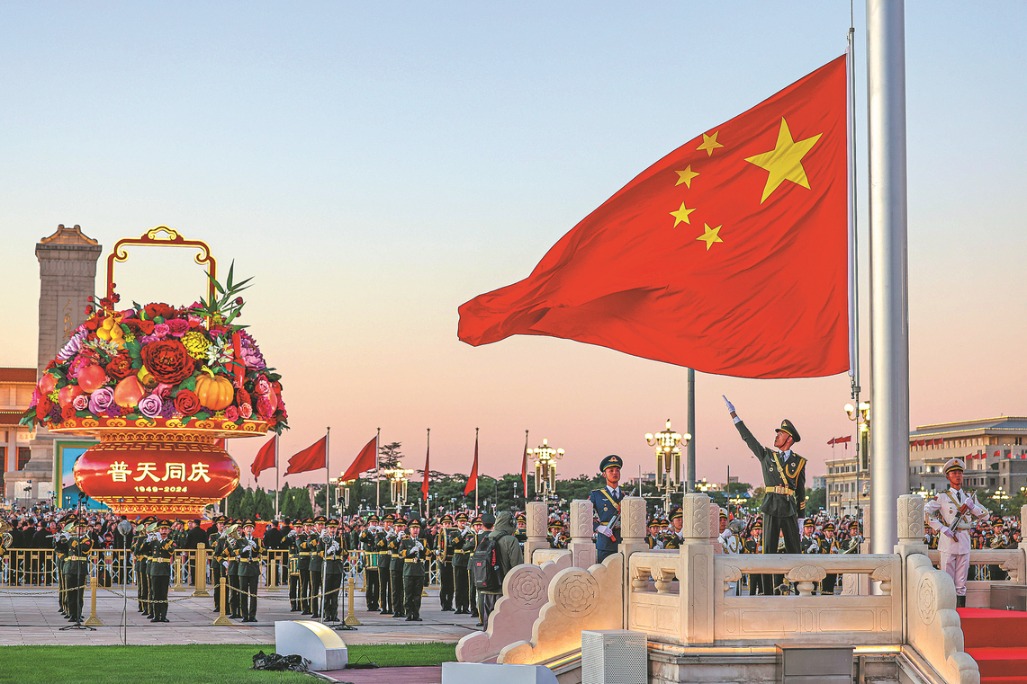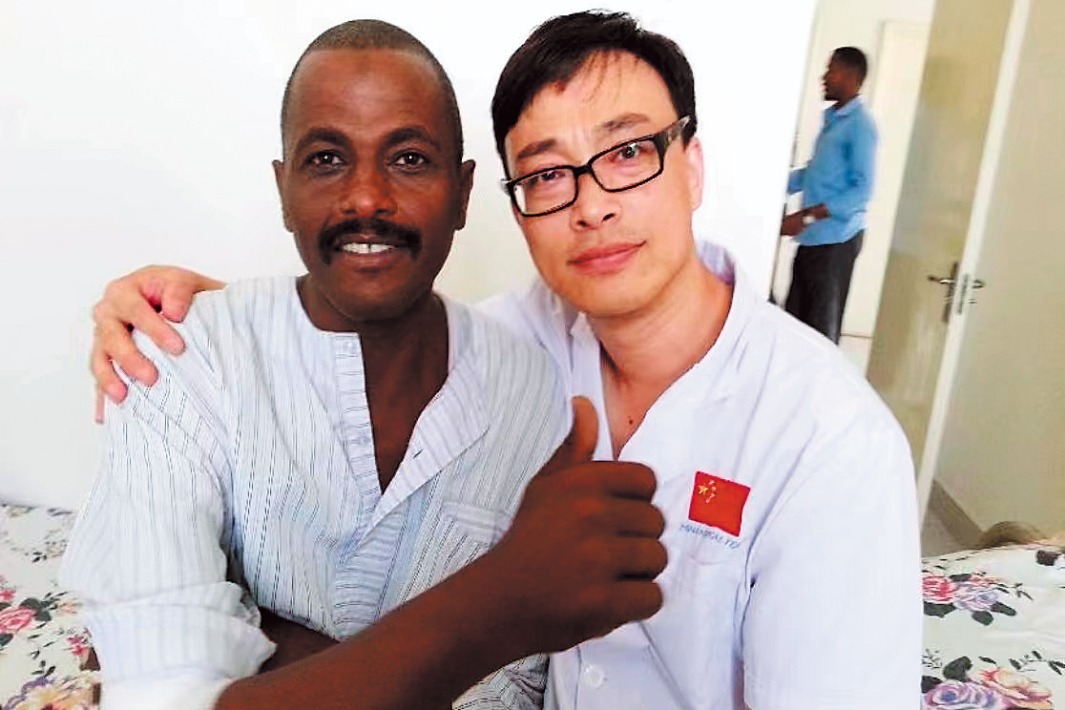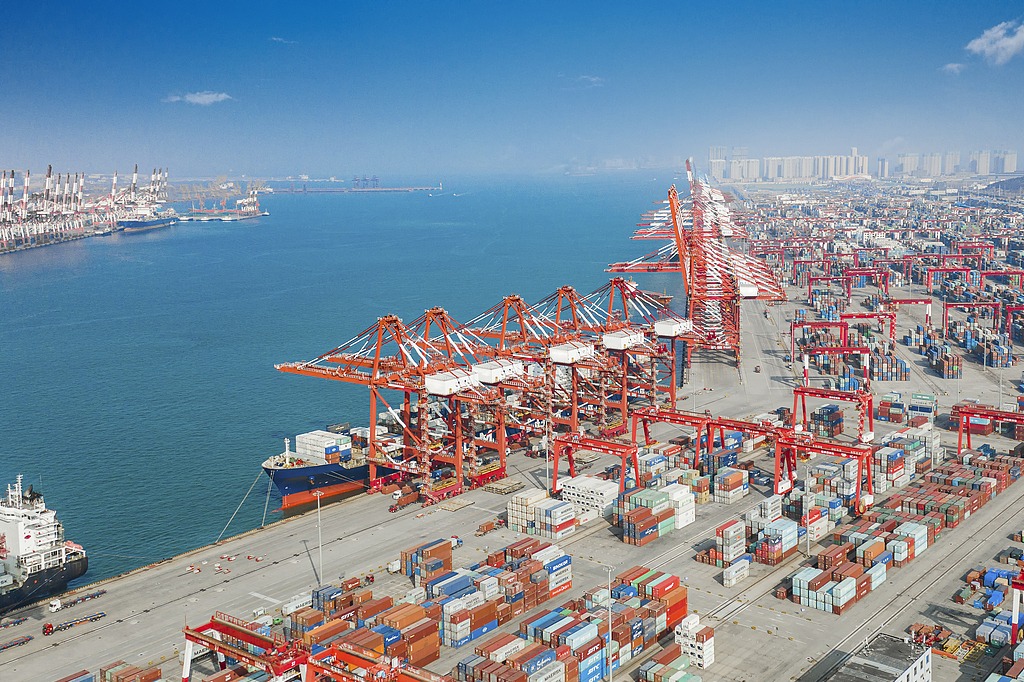The BRI progress, contributions and prospects
China Daily | Updated: 2019-04-23 08:08
・ Railways
Major progress has been made in building inter-regional and intercontinental railway networks focusing on such cooperation projects as the China-Laos Railway, China-Thailand Railway, Hungary-Serbia Railway, and Jakarta-Bandung High-Speed Railway.
Preliminary research has advanced on the eastern route of the Pan-Asia Railway Network, the upgrade of Pakistan's Karachi-Peshawar Railway Line (also referred to as Main Line 1 or ML-1), and the China-Kyrgyzstan-Uzbekistan Railway. A pre-feasibility study on a China-Nepal cross-border railway has been completed.
After preliminary work on China Railway Express cargo trains, an international railway operation mechanism with cooperation among multiple countries has been established. Railway companies of China, Belarus, Germany, Kazakhstan, Mongolia, Poland, and Russia have signed an agreement on deeper cooperation in China-Europe rail service. By the end of 2018, China-Europe rail service had connected 108 cities in 16 countries in Asia and Europe. A total of 13,000 trains had carried more than 1.1 million TEUs. Among the trains starting from China, 94 percent were fully loaded; and among those arriving in China, 71 percent were fully loaded.
China has cooperated with other B&R countries in customs clearance to make it more convenient and efficient for the operation of the trains. The average inspection rate and customs clearance turnover time have both decreased by 50 percent.
・ Roads
Trial operations have been carried out on nonstop transport on the China-Mongolia-Russia, China-Kyrgyzstan-Uzbekistan, China-Russia (Dalian-Novosibirsk) and China-Viet Nam roads. In February 2018, regular operation began on the China-Kyrgyzstan-Uzbekistan highway. China-Viet Nam Beilun River Bridge II has been completed and opened to traffic. China formally joined the Convention on International Transport of Goods Under Cover of TIR Carnets (TIR Convention). It has signed 18 bilateral and multilateral international transport facilitation agreements with 15 B&R countries, including the "Intergovernmental Agreement of the Shanghai Cooperation Organization Member States on the Facilitation of International Road Transport". Positive progress has been made in implementing the GMS "Agreement for the Facilitation of Cross-Border Transport of Goods and People".
・ Ports
In Pakistan's Gwadar Port, routes for regular container liners have been opened and supporting facilities in the starting area of the Gwadar Free Trade Zone completed, attracting more than 30 companies into the area. Preliminary work has been completed for Sri Lanka's Hambantota Port Special Economic Zone, including defining the zone's industrial functions and making conceptual plans. An important transit hub has been completed at the Port of Piraeus in Greece, and Phase III construction is to be completed. Khalifa Port Container Terminal Phase II in the United Arab Emirates officially opened in December 2018. China has signed 38 bilateral and regional shipping agreements with 47 B&R countries. China's Ningbo Shipping Exchange has made constant efforts to improve the Maritime Silk Road Freight Index and released the China-CEEC Trade Index (CCTI) and the Ningbo Port Index.
・ Air transport
China has signed bilateral intergovernmental air transport agreements with 126 countries and regions. It has expanded arrangements for air traffic rights with Luxembourg, Russia, Armenia, Indonesia, Cambodia, Bangladesh, Israel, Mongolia, Malaysia, and Egypt. Over the past five years or so, 1,239 new international routes have opened between China and other B&R countries, accounting for 69.1 percent of the total of China's new international routes over that period.
・ Energy facilities
China has signed a large number of cooperation framework agreements and MoUs with other B&R countries, and has carried out extensive cooperation in the fields of electricity, oil and gas, nuclear power, new energy, and coal. It works with relevant countries to ensure the safe operation of oil and gas pipeline networks and optimize the configuration of energy resources between countries and regions.
The China-Russia crude oil pipeline and the China-Central Asia natural gas pipeline have maintained stable operation. Certain sections of the eastern route of the China-Russia natural gas pipeline will enter service in December 2019 and the entire eastern route will be completed and enter service in 2024. China-Myanmar oil and gas pipelines have been completed.
・ Communication facilities
Significant progress has been made in the construction of China-Myanmar, China-Pakistan, China-Kyrgyzstan, and China-Russia cross-border fiber optic cables for information transmission. China and the International Telecommunication Union signed a "Letter of Intent to Strengthen Cooperation on Telecommunications and Information Networks Within the Framework of the Belt and Road Initiative". China has also signed cooperation agreements with Kyrgyzstan, Tajikistan and Afghanistan on fiber optic cables, which represent the practical launch of the Silk Road Fiber Optic Cable project.
3.Unimpeded trade
Unimpeded trade is an important goal of the Belt and Road Initiative. The efforts invested in the initiative have liberalized and facilitated trade and investment in the participating countries and regions, lowered the costs of trade and business, and released growth potential, enabling the participants to engage in broader and deeper economic globalization.
1. Greater liberalization and facilitation of trade and investment. China has issued the "Initiative on Promoting Unimpeded Trade Cooperation Along the Belt and Road", to which 83 countries and international organizations have subscribed. Cooperation in border inspection and quarantine has deepened. Since the first Belt and Road Forum for International Cooperation in May 2017, China has signed more than 100 cooperation agreements with other B&R countries, granting access to some 50 types of agricultural products and food after inspection and quarantine. Express customs clearance services for agricultural products between China and Kazakhstan, Kyrgyzstan, and Tajikistan have reduced the clearance time by 90 percent. China has further expanded sectors accepting foreign investment to create a business environment of high international standards. It has opened 12 pilot free trade zones for global business and experimented with free trade ports to attract investment from participating countries of the Belt and Road Initiative. China's average tariffs have dropped from 15.3 percent when it joined the World Trade Organization to 7.5 percent today. China has signed or upgraded free trade agreements with ASEAN, Singapore, Pakistan, Georgia and other countries and regions, and signed an economic and trade cooperation agreement with the Eurasian Economic Union. A network of free trade areas involving China and other B&R countries has taken shape.
2. Expanding trade. From 2013 to 2018 the value of trade between China and other B&R countries surpassed US$6 trillion, accounting for 27.4 percent of China's total trade in goods and growing faster than the country's overall foreign trade. In 2018 the value of trade in goods between China and other B&R countries reached US$1.3 trillion, growing by 16.4 percent year on year. Trade in services between China and other B&R countries has seen steady progress, growing by 18.4 percent from 2016 to reach US$97.76 billion in 2017. The figure accounted for 14.1 percent of China's total trade in services, 1.6 percentage points higher than in 2016. According to a World Bank study that analyzes the impact of the Belt and Road Initiative on trade in 71 potentially participating countries, the initiative increases trade flows among participating countries by up to 4.1 percent.*
* Suprabha Baniya, Nadia Rocha & Michele Ruta, "Trade Effects of the New Silk Road: A Gravity Analysis"-World Bank Policy Research Working Paper 8694, January 2019.
3. Faster pace of trade model innovation. New trade models such as cross-border e-commerce are becoming an important driver of trade. In 2018 the total value of retail goods imported and exported through the cross-border e-commerce platform of China Customs reached US$20.3 billion, growing by 50 percent year on year. Exports were US$8.48 billion, growing by 67 percent year on year, and imports were US$11.87 billion, growing by 39.8 percent year on year. As Silk Road e-commerce prospers, China has established cooperation mechanisms for bilateral e-commerce with 17 countries, created agreements on e-commerce cooperation under the BRICS and other multilateral frameworks, and made solid progress in finding overseas partners for Chinese businesses and developing Chinese brands.
4. Financial integration
Financial integration is an important pillar of the Belt and Road Initiative. Exploring investment and financing models, international multilateral financial institutions and commercial banks have played an innovative role in expanding the channels of diversified financing, providing stable, transparent and quality financial support for the Belt and Road Initiative.
1. Exploring new models of international investment and financing. Boasting huge cooperation potential in infrastructure construction and industrial capacity, the Belt and Road Initiative is in urgent need of finance. The sovereign wealth funds and investment funds of the participating countries are playing a bigger part. In recent years the Abu Dhabi Investment Authority of the UAE, China Investment Corporation and other sovereign wealth funds have markedly increased investment in major emerging economies participating in the initiative. The China-EU Joint Investment Fund, which began operation in July 2018 with an injected capital of 500 million euros from the Silk Road Fund and the European Investment Fund, has helped the Belt and Road Initiative to dovetail with the Investment Plan for Europe.
2. Growing support from multilateral financial cooperation. China's Ministry of Finance and its counterparts in 27 countries including Argentina, Russia, Indonesia, the UK, and Singapore have endorsed the "Guiding Principles on Financing the Development of the Belt and Road". According to the Principles, the countries participating in the Belt and Road Initiative support channeling of financial resources to serve the real economy of countries and regions involved, with priority given to such areas as infrastructure connectivity, trade and investment, and industrial cooperation, among others. The People's Bank of China has rolled out joint financing programs with the International Finance Corporation under the World Bank Group, Inter-American Development Bank, African Development Bank, European Bank for Reconstruction and Development, and other multilateral development institutions. By the end of 2018 these institutions had invested in more than 100 programs in over 70 countries and regions. Established in November 2017, the China-CEEC Bank Consortium includes 14 financial institutions from China, Hungary, the Czech Republic, Slovakia, Croatia, and nine other Central and Eastern European countries. In July 2018 the China-Arab States Bank Consortium was founded, followed by the China-Africa Financial Cooperation Consortium established in September; each was the first multilateral financial cooperation mechanism between China and the respective area.
3. Closer cooperation between financial institutions. In building the Belt and Road, policy-backed export credit insurance, which has wide coverage, plays a special role in supporting infrastructure and basic industries. The strengths of commercial banks lie in taking deposits from wider sources, corporate financing, financial products, trade agency, and trust services. By the end of 2018 the China Export & Credit Insurance Corporation had endorsed US$600 billion on export to and investment in the participating countries. Chinese-financed banks, such as the Bank of China, Industrial and Commercial Bank of China, Agricultural Bank of China, and China Construction Bank, have formed extensive agent banking relations with the participating countries. Commerzbank became the first German bank to join the banking mechanism of the Belt and Road Initiative when it signed an MoU on cooperation with the Industrial and Commercial Bank of China.
4. Improved financial market system. The initiative's participating countries have made continued efforts to consolidate and improve financial cooperation for long-term benefits and win-win outcomes. With a steady supply of innovative financial products, channels for financing the Belt and Road Initiative have expanded substantially. China has continued to open up its interbank bond market. By the end of 2018 about RMB200 billion of Panda bonds had been issued. The Export-Import Bank of China issued a RMB2 billion green bond for global investors, and the BRICS New Development Bank issued a RMB3 billion green bond to support the green development of the Belt and Road Initiative. Stock equity, business and technical cooperation between securities and futures exchanges has advanced. The Shanghai Stock Exchange, Deutsche Borse Group, and China Financial Futures Exchange jointly founded the China Europe International Exchange in 2015, and the Shanghai Stock Exchange and Astana International Financial Center Authority of Kazakhstan have signed an agreement to co-invest in building the Astana International Exchange.
5. Deeper financial connectivity. Eleven Chinese-funded banks have set up 76 first-grade institutions in 28 B&R countries, and 50 banks from 22 B&R countries have opened 7 corporate banks, 19 branches, and 34 representative offices in China. Two Chinese-funded securities firms have established joint ventures in Singapore and Laos. China has made bilateral currency swap arrangements with more than 20 B&R countries and Renminbi clearing arrangements with 7 B&R countries, and signed cooperation agreements with the financial supervision authorities of 35 B&R countries. The Reminbi's functions as a currency for international payment, investment, trade, and reserve have been strengthened. The Cross-Border Interbank Payment System (CIPS) now covers some 40 countries and regions involved in the Belt and Road Initiative. The China-IMF Capacity Development Center and the Research Center for the Belt and Road Financial and Economic Development have been founded.
5. Closer people-to-people ties
People-to-people ties are the cultural foundation for building the Belt and Road. It is the common dream of all peoples to enjoy a peaceful and prosperous life. Over the past five years or so, the B&R countries have carried out diplomatic activities and cultural exchanges of various forms in wide fields, enhancing mutual understanding and recognition and laying a solid cultural foundation for furthering the initiative.
・ Diverse forms of cultural exchange. China and other B&R countries have hosted events such as arts festivals, film festivals, music festivals, cultural relics exhibitions, and book fairs, and have jointly launched new publishing, radio, film and television programs, as well as translating and introducing each other's media programs. The Silk Road International League of Theaters, Silk Road International Museum Alliance, Network of Silk Road Arts Festivals, Silk Road International Library Alliance, and Silk Road International Alliance of Art Museums and Galleries have been established. China, CEE countries, ASEAN countries, Russia, Nepal, Greece, Egypt, and South Africa have hosted activities to celebrate the cultures of B&R countries in different years, and developed about a dozen cultural exchange brands such as the "Silk Road Tour" and "Chinese/African Cultures in Focus". Major cultural festivals and expos have been launched such as the Silk Road (Dunhuang) International Cultural Expo, Silk Road International Arts Festival, and Maritime Silk Road International Arts Festival, and 17 Chinese culture centers have been set up in B&R countries. China has signed cooperation agreements on the protection of cultural heritage with Indonesia, Myanmar, Serbia, Singapore, and Saudi Arabia. Through a combined effort from China, Kazakhstan and Kyrgyzstan, Silk Roads: The Routes Network of Chang'an-Tian Shan Corridor has become a UNESCO World Heritage site. Steady progress has been made in the Belt and Road News Alliance. The Silk Road NGO Cooperation Network, with 310 members, has become an important platform for nongovernmental cooperation.
・ Fruitful results in education and training. The Chinese Government Scholarship-Silk Road Program has been set up, and China has signed agreements with 24 B&R countries on the mutual recognition of higher education degrees. In 2017, 38,700 students from other B&R countries studied in China on scholarships provided by the Chinese government, accounting for 66 percent of all students receiving such scholarships. Other B&R scholarships are provided in the Hong Kong and Macao SARs. China has opened 153 Confucius Institutes and 149 Confucius Classrooms in 54 B&R countries. The Chinese Academy of Sciences offers scholarships in Master's and Doctorate programs to other B&R countries, and runs science and technology training courses which have trained some 5,000 students from other B&R countries.
・ Expanding cooperation in tourism. China has held joint year of tourism with many other B&R countries, initiating cooperation mechanisms such as the Silk Road Tourism Promotion Union, Maritime Silk Road Tourism Promotion Alliance, and Tea Road International Tourism Alliance. China has signed mutual visa exemption agreements for different types of passport with 57 B&R countries, and concluded 19 agreements or arrangements to streamline visa application procedures with 15 countries. In 2018 outbound Chinese tourists numbered 150 million, and inbound foreign tourists numbered 30.54 million. Russia, Myanmar, Vietnam, Mongolia, Malaysia, the Philippines, and Singapore were the main sources of tourists for China.
・ Deeper cooperation in health and medicine. Since the first Belt and Road Forum for International Cooperation, China has signed 56 agreements on cooperation in the health sector with countries such as Mongolia and Afghanistan, international organizations such as the World Health Organization, and NGOs such as the Bill & Melinda Gates Foundation. In August 2017 the Belt and Road High-Level Meeting for Health Cooperation: Towards a Health Silk Road was held in Beijing, which issued the "Beijing Communique of the Belt and Road Health Cooperation". China has carried out cooperation on the prevention and control of AIDS, malaria, dengue, flu, and tuberculosis with Lancang-Mekong countries; on the prevention and control of echinococcosis, plague and other zoonoses with Central Asian countries; and on the prevention and control of polio with Western Asian countries. China has dispatched ophthalmology teams to Cambodia, Myanmar, Laos, and Sri Lanka to carry out the "Brightness Action" program, and short-term medical teams to island countries such as Fiji, Tonga, Micronesia, and Vanuatu in the Pacific. It has established traditional Chinese medicine centers in 35 B&R countries, and 43 international TCM cooperation bases.
・ Ongoing effort in disaster relief, assistance, and poverty alleviation. Since the first Belt and Road Forum for International Cooperation, China has provided RMB2 billion in emergency food assistance to developing countries participating in the initiative, injected an additional US$1 billion to the South-South Cooperation Assistance Fund, and implemented 100 Happy Home Projects, 100 Anti-Poverty Projects, and 100 Health Recovery Projects. China has participated in 8 joint programs for the protection of cultural relics with 6 countries, and 15 joint archaeological activities with 12 countries. China has provided Laos and other countries with seismic monitoring equipment to improve their early warning and disaster alleviation capacity. China has initiated 24 cooperation programs with civil society organizations in Cambodia and Nepal, in an effort to improve the lives of local people.
6. Industrial cooperation
The Belt and Road Initiative draws investment from diverse sources, encourages third-party market cooperation, and aims to build industry, supply, service, and value chains that benefit all and are shared by all, so as to provide new growth drivers for faster development in the participating countries.
1. Stable growth in China's direct investment in B&R countries. From 2013 to 2018 China's direct investment in B&R countries surpassed US$90 billion, realizing a turnover of US$400 billion in foreign contracted projects in these countries. In 2018 Chinese businesses made a total of US$15.6 billion in nonfinancial direct investment in B&R countries, growing by 8.9 percent year on year and accounting for 13 percent of China's total nonfinancial FDI during the same period. The turnover of foreign contracted projects in B&R countries reached US$89.3 billion, or 53 percent of the total turnover of foreign contracted projects in the same period. According to a World Bank study, the transportation network proposed by the Belt and Road Initiative can lead to a 4.97-percent increase in total FDI flows to B&R countries, a 4.36-percent increase in FDI flows within B&R countries, a 4.63-percent increase in FDI flows from OECD countries, and a 5.75-percent increase in FDI flows from non-B&R countries.*
* Maggie Xiaoyang Chen& Chuanhao Lin, "Foreign Investment Across the Belt and Road: Patterns, Determinants and Effects"-World Bank Policy Research Working Paper 8607, October 2018.
2. Steady progress in international cooperation on industrial development and third-party markets. As faster growth in B&R countries has generated huge market demands on international industrial cooperation, China has taken active measures to boost market-oriented industrial cooperation with relevant countries in all areas, so as to upgrade the industrial structure and raise the level of industries in these countries. Currently China has signed agreements on industrial cooperation with more than 40 countries including Kazakhstan, Egypt, Ethiopia, and Brazil. It has dovetailed industrial cooperation programs with regional organizations such as the ASEAN, African Union, and the CELAC. China has signed third-party market cooperation agreements with France, Italy, Spain, Japan, and Portugal.
3. Vigorous development in cooperation parks and zones.
Applying market principles and complying with laws, Chinese businesses of all types have joined in the development of cooperation parks and zones in other B&R countries, sharing China's best practices and the experience it has gained in development zones and industrial parks during reform and opening up. In addition to promoting the local economy, these have also created new sources of tax revenue and jobs in the countries involved. China has established the China-Kazakhstan Khorgos International Border Cooperation Center, and the China-Laos Mohan-Boten Cross-Border Economic Cooperation Zone; more cross-border economic cooperation zones with other countries are being planned or built.
























